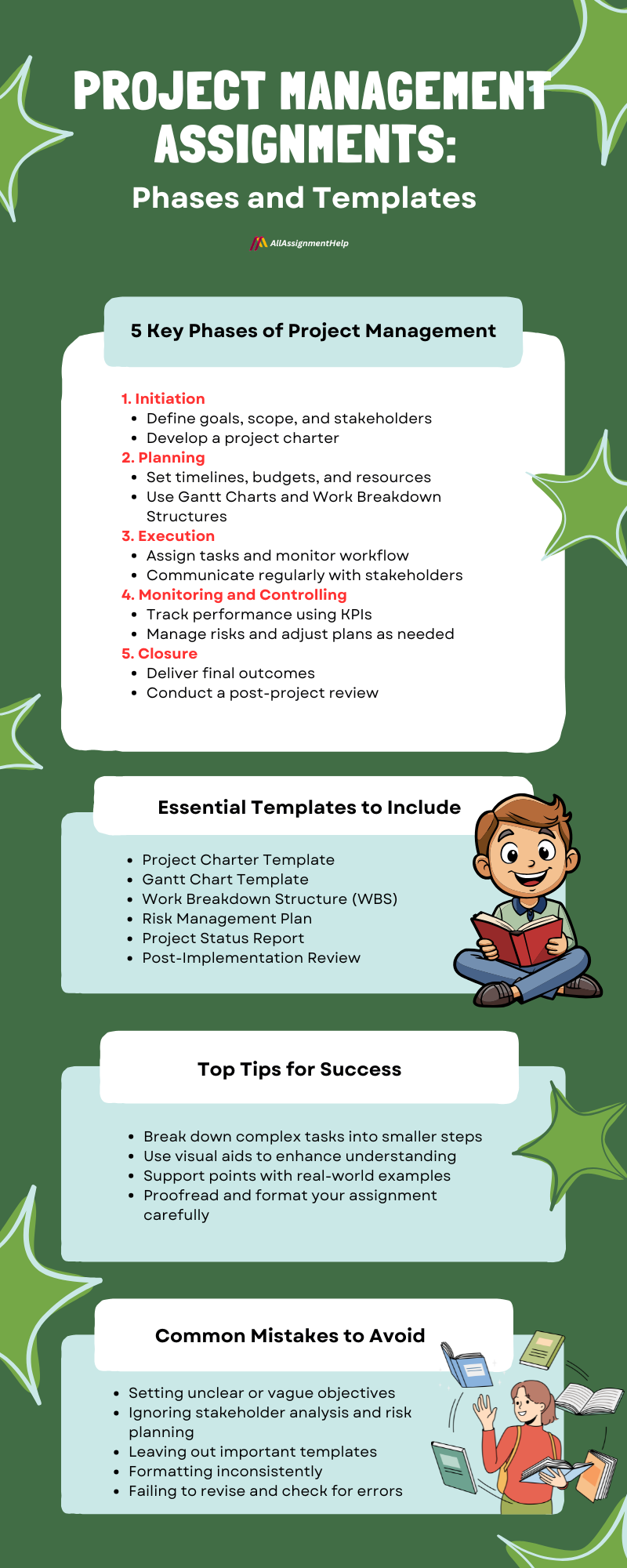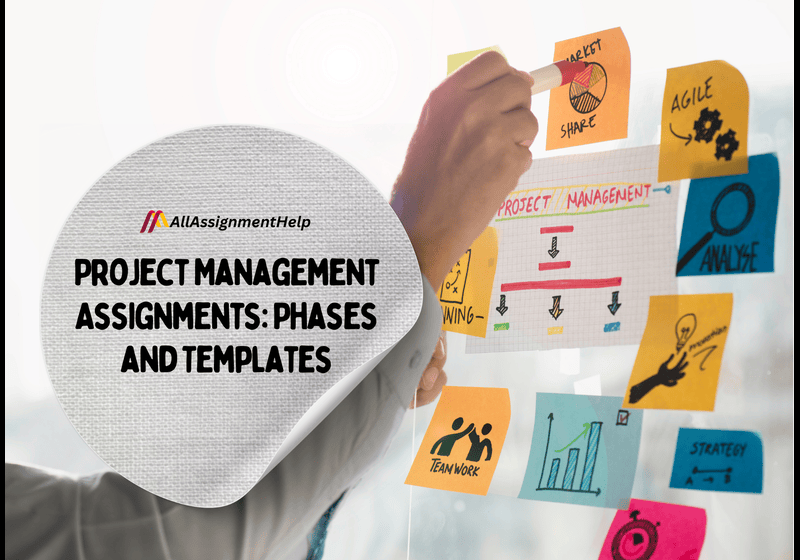Table of Contents
Project management is one of the most important skills in academia and industry. Whether you are working on a small group project for class or a large business project, project management is an essential tool to share work and school projects and submit them on time. Moreover, project management homework and assignments can serve as experiences for students, giving them exposure to how to draft, plan, execute, and deliver tasks. The best method to approach those assignments is to divide them into manageable steps and work with ready templates that correspond with these steps.
Templates are visual reminders that keep everyone on the same page and ensure that all the important points are not forgotten. In this blog by All Assignment Help, we will explore the five key stages of project management in more depth and point out the most effective templates to use.
What is Project Management?
Project management is the organised approach to the planning and execution of a series of predictable goals using different strategies in a set amount of time and resources. It is a mix of what you know, what you can do, what you have, and how you apply it to the project at hand. Essentially, project management is what it takes to get the job done right, on schedule and within budget. It is also a prime subject students come across in the fields of business, IT, management, and engineering studies, where they are expected to perform real-life projects.
Knowing the important points like project scope, resource allocation, risk management, and stakeholder communication is the key to success. Students approach online assignment help as they struggle to understand these complicated ideas. These services also help students to work on concepts that need strategic plans and practical tools, such as Gantt charts or risk matrices. By providing this support, learners gain visibility on how each stage of a project aligns with the next. The basics are the first step in project management, whether tackling a class project or preparing for a career as a project coordinator.
Also read: Things to Ponder About Human Resource Management
The Five Key Phases of Project Management
Initiation phase
The initiation phase is the phase in which the project is born. It includes defining the purpose of the project, identifying stakeholders, and determining if the project is viable. Some critical documents generated during this phase are the project charter and a high-level cost, resource, and risk analysis. The communication in this phase is very significant because it gives the whole project its direction, clarity, and focus. If students are working on project management assignments, students must present an in-depth initiation plan that shows clarity on the objectives and outcomes. However, those who are not aware of this phase take the assistance of project management assignment help so that they can synchronise practical knowledge with the theory part. A strong initiation phase creates a path which all future activities follow, streamlining the management of time, scope, and stakeholder expectations throughout the assignment.
Planning phase
Planning converts ideas into a plan of action. In this phase, students are making schedules, assigning tasks, allocating resources, and conducting risk assessments. Some common tools are work breakdown structures (WBS), Gantt charts, and risk management plans. This is an important phase in learning as well as execution that gets us to commit fewer mistakes and do things better. This means students getting additional academic support, like online class help, can get some relief from keeping everything well-managed and planned for the project. When you plan well, you can execute smooth actions and foresee possible issues. A project plan that includes visual tools and timelines in your project management assignments demonstrates your capability to anticipate conflicts and to organise work effectively.
Execution phase
The execution phase executes all the planning. In this phase, the teams fulfil the obligations delineated by the arrangement, organise with partners, and keep the venture undertakings on track. Keep track of how resources are used, what the flow of communication is, and how deliverables are tracked; students need to know or learn these steps. These assignments would centre on task status reports, coordination of team efforts, and adaptations made during development. Moreover, students with various overlapping tasks could ask for academic support with requests like take my online exam for me, take my online class, etc. This enables them to devote more time to hands-on project work and not lag academically. Since execution is where most of the budget and effort for the project go, illustrating how everything comes together in this phase is indicative of your practical understanding of project management.
Monitoring and controlling phase
In parallel with execution, project performance is measured, and adjustments are made in this phase. Monitoring of KPIs, risk identification, change management, and ensuring the work remains within scope, time, and budget are all part of it. A student should demonstrate an ability to monitor steps taken and apply corrective measures. This is where charts, metrics, and logs of system performance come in handy. Assignment examples in this part are a useful way of improving this accuracy, as these two factors require analytical thinking, indirect association and strategic decision-making. The features of a good monitoring and controlling part demonstrate that you are still able to adjust to what is happening in real-time without losing focus on the ultimate objectives. This phase demonstrates your capacity to work under uncertainty, which is an important trait in academic research and working in project management positions in the industry.
Closure phase
It is also known as the closure phase and signals the formal end of the project. This process includes completion of all activities, performance assessment of the project, release of project resources, and recording lessons learnt. Students need to develop a closure report that encapsulates a project as per its deliverables, achievements, learning experiences and any recommendations for changes in the future. Perhaps their most common mistake in assignments is to miss this phase, despite it giving useful indicators. When deadlines loom overhead, seeking academic-help services during this stage can help prepare meaningful summaries and reflection portions of the project. A closing phase that is documented well shows that you can take lessons learnt and put them into practice.
Also read: All You Need to Know About Project Management

Essential Templates Used in Project Management Assignments
When it comes to project management assignments, templates are crucial because they facilitate structure, clarity, and consistency at each phase of the project. Students can use it to organise information effectively, keep track of deliverables and data, and report it in a presentation-qualified manner. Whether you are framing a new project or rounding up a completed one, the right template for presentation and analysis elevates the process.
Commonly used templates:
- Project charter template
- Gantt chart template
- Risk management plan
- Work breakdown structure
- Project status report template
- Post-implementation review template
Perhaps the most frequently used template is the Project Charter Template, utilised in the initiation phase to outline goals, stakeholders, and scope. During the planning stage, this Gantt Chart Template is a great tool, as it can illustrate your project’s timeline, milestones, and task dependencies. The WBS (Work Breakdown Structure) is another important tool that subdivides large tasks into subtasks. While these templates simplify planning, they also demonstrate how a student manages the complexity.
Why risk templates matter
In the monitoring phase, progress tracking and project status updates use the Project Status Report Template. At the same time, the Risk Management Plan Template is one more important aspect of it, as once the risks are identified, they are analysed and mitigated easily. This is an analytical part, and many students find it difficult to deal with, which is why they require risk management assignment help. Aspects related to risks will be very crucial in your management coursework to score decently , and expert support will make sure that those sections are well-detailed, realistic, and aligned with the project objectives.
As a final step, the post-implementation review template encourages critical reflection in considering what went well and what could be improved to ensure successful projects moving forward. Using specific templates in each phase exhibits a versatility of knowledge in project management concepts. It also strengthens the ability to think critically, manage time, and communicate skills. These skills are not only important in academic tasks but also in real-life project situations. Not only does it save time, but it also enhances the quality and credibility of your submission.
Tips for Writing Effective Project Management Assignments
Understanding what project management is all about is only one aspect of writing a good project management assignment. However, the other way is a well-defined structure, appropriate templates and examples.
- To begin, read the assignment instructions thoroughly and divide the project into the five phases of project management: initiating, planning, executing, monitoring and controlling, and closure.
- Check it out: what visuals can be used (Gantt charts and risk matrices can be proven)?
- Sprinkle your analysis with practical or case-based examples that demonstrate the application of concepts.
- Time management is also an important factor; try to have enough time for researching, crafting, and revising.
- Do not make unsubstantiated statements. Be definite on targets, assets, time frames, and consequences.
- Edit for grammatical accuracy and flow between sections.
- In case you are overlapping topics such as finance or HR, get support from business management assignment help to combine all of them under the project. Assistance from experts can improve content quality and help in achieving better grades.
Common Mistakes to Avoid
In project management assignments, students tend to lose marks on points that they can avoid easily.
- A frequent blunder is bypassing the planning stage or giving general objectives and timeframes.
- Another is to use content generically without adapting to the content of the project.
- In the absence of templates to track, e.g., when it comes to Gantt charts or risk management plans, the framework suffers as well.
- Ignoring stakeholder analysis or not accounting for risk factors are signs of surface thinking.
- Also, bad formatting and a lack of proofreading can lead to less clarity.
Each of these phases should be well-defined and supported with charts and graphs, with a good alignment with real-world practices and academic requirements to have a good score.
Conclusion
Project management assignments are a good way to implement theoretical elements in practice. Students can develop comprehensive and robust projects by learning these five critical phases of project management: initiation, planning, execution, monitoring, and closure. Gantt charts, risk plans, status reports, etc., are essential for clarity and professionalism. Staying away from common blunders can lead to a marked improvement in quality and grades. Thoughtful planning, meticulous organisation, and effective delivery make project management assignments easier to handle and to implement.
Frequently Asked Questions
Question: What are the major stages of a project management assignment?
Answer: The five big phases of project management are initiation, planning, execution, monitoring, and closure.
Question: What are the must-have templates for project management assignments?
Answer: Things like Gantt chart templates, project charts, risk management plan, status reports, etc., are all the essentials.
Question: What can I do to make my project management assignment better?
Answer: Use real-world examples and structured templates, and avoid vagueness to add depth.
Question: Why is risk management needed in project assignments?
Answer: It allows you to spot and solve problems long before they occur in order to keep the project on target and on scope.
